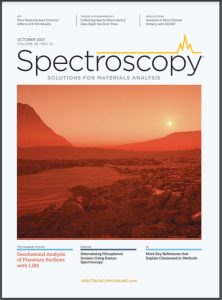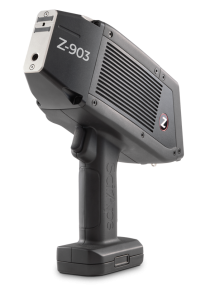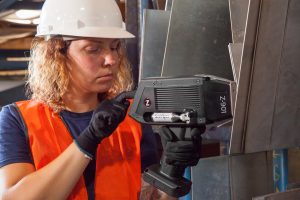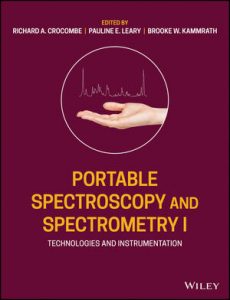LIBS technology has migrated from an obscure laboratory analysis method to a mainstream field analytical technique in recent years.
LIBS—laser induced breakdown spectroscopy—utilizes a pulsed laser that vaporizes a small region of a sample approximately 100 um in diameter and 5-10 um in depth. The resulting plasma cools and emits light in the UV/Vis/IR range that is captured by one or more on-board spectrometers, depending upon the spectrometer range required.

READ “HANDHELD LIBS – THE LATEST SUCCESS STORY IN PORTABLE ANALYTICAL INSTRUMENTATION” BY DON SACKETT, SCIAPS CEO, IN THE RECENT EDITION OF SPECTROSCOPY MAGAZINE.
The advancement in laser technology was the key to recent commercial field successes. A viable field LIBS system had to offer speed, be lightweight, operate with batteries and perform over a wide thermal range, while providing necessary high pulse energies and high pulse repetition rates.
Developing an instrument that met all these challenges proved to be a time consuming process, but was ultimately successful.
For example, the laser used in a SciAps device today delivers 6-8 millijoules/pulse at a 50 Hz repetition rate with a 2 ns pulse width over a temperature range of 25 – 45C. This type of laser performance has proven critical to achieve the field analytical performance of mobile spark optical emission (spark OES) or handheld X-ray fluorescence (HHXRF).
Handheld LIBS has met commercial acceptance in several critical areas.
Perhaps the best example is in the field of carbon analysis in steel and stainless alloys. Many industries require the carbon equivalent value for steel for correct welding procedures, and low-carbon grade stainless steel is often specified for many chemical and energy processes. LIBS is the only handheld technique capable of making this demanding carbon measurement. In fact, the SciAps handheld LIBS is now accepted globally by most industries that are using, fabricating, or making steels and stainless, where it’s become a disruptive technology to traditional mobile spark OES systems.
The green economy/electric vehicle sector offers an emerging success story. Handheld LIBS is the only field technique that measures lithium content in soils, ores, and brines. As such, it’s rapidly becoming a vital tool in efficient exploration as the world seeks to expand lithium production to meet the battery metals demand from the EV industry and being put to service in recycling/recovery of used batteries.
Handheld LIBS uniquely offers flexibility not found with other field analytical techniques. Because LIBS technology can create emissions from every stable element in the periodic table, a well- conceived platform offers cost effective configurations for specific measurements. Rather than the expense of a full-range system that spans emissions from 190 nm – 950 nm, users can obtain custom-configured systems optimized for a specific emission range.

Recent examples include a single spectrometer analyzer optimized in the 580 – 780 nm range to measure fluorine, as a tool for in-field screening for PFAS (per- and polyfluoroalkyl substances) in various packaging and consumer products. Other examples include optimized spectrometer ranges for beryllium measurements in soil and dust as part of site clean-ups, particularly at some U.S. aging weapons-making facilities, and suites of light elements such as fluorine, sodium, and boron in a range of mineral samples.
Handheld LIBS has found a home in the academic world as well, driven largely by the dual-purpose capability of quantitative field measurement plus its value as a classroom teaching tool in many chemistry, physics, geoscience, and metallurgy departments. A litany of interesting applications have evolved over the past 5-10 years by university researches and government laboratories, and many are detailed at https://sciaps.com/resource-library/independent_studies/
In summary, the past 5-10 years have witnessed the birth of handheld LIBS as a viable new portable analytical technology. The technology has achieved commercial success in traditional industries like chemical, petrochemical and oil/gas, as well as providing crucial field analysis for new industries such as electric vehicles, strategic metals, and emerging environmental threats such as fluorine-containing organic compounds.
Handheld LIBS first found commercial success in alloy analysis industries. It’s now being applied to electric vehicles, strategic metals, environmental clean-up, space exploration and more.

In “In-field Chemistry Everywhere,” Russell Harmon, Ph.D., shares his thoughts on unleashing the potential of this powerful portable instrument.

RUSSELL HARMON IS ADJUNCT ASSOCIATE PROFESSOR, DEPARTMENT OF MARINE, EARTH, & ATMOSPHERIC SCIENCES, NORTH CAROLINA STATE UNIVERSITY
Current developments and future prospects are fully covered, along with scientific review, in Spectrochimica Acta Part B: Atomic Spectroscopy, 175 (2021), and also this year, SciAps CTO David Day contributed his knowledge and expertise to “Portable Spectroscopy and Spectrometry: Volume One” (Wiley), the first comprehensive work to describe the enabling technologies of portable spectrometry. Day wrote Chapter 13: Handheld Laser Induced Breakdown Spectroscopy (HHLIBS), which explains the development of handheld LIBS and its specifications.










